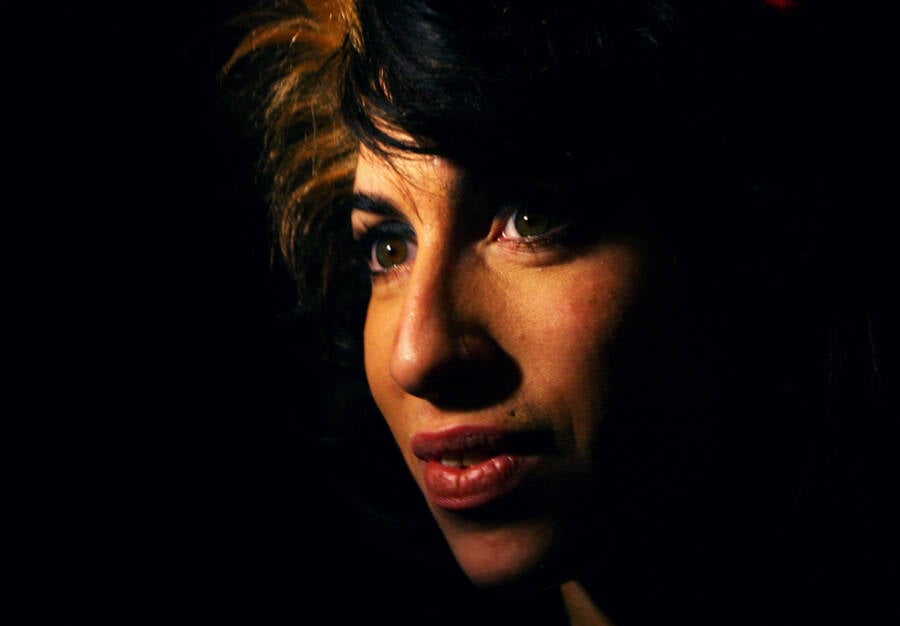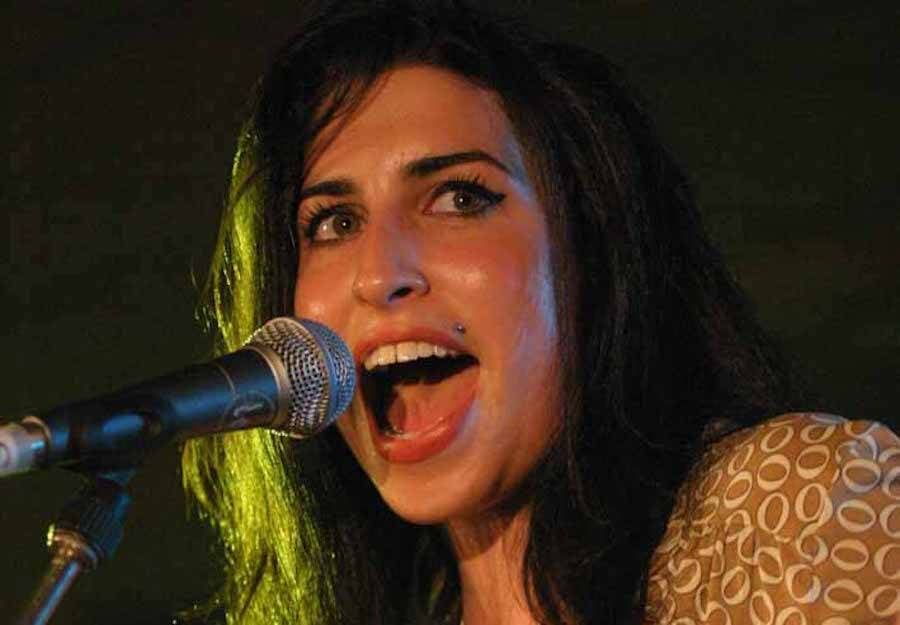Go inside the tragic life and death of Amy Winehouse, the iconic British singer-songwriter whose emotional lyrics and powerful singing made her a household name.
Before the long downward spiral that ended with Amy Winehouse’s death, the British chanteuse channeled her love of soul and jazz into an eclectic form of pop that resonated with countless people. While the world adored songs like “Rehab,” that smash hit also hinted at her very real struggles with substance abuse. Ultimately, her demons got the better of her and on July 23, 2011, Amy Winehouse died of alcohol poisoning in her London home at just 27 years old.
Though people around the globe mourned this sudden loss, few — especially those who knew her best — were surprised. In the end, the story of how Amy Winehouse died was tragically foreshadowed by the way she lived.
“Rehab” may have set off some alarm bells in 2006, but the warning signs soon became starker in the public eye. As the spotlight of fame grew harsher, so did Winehouse’s reliance on drugs to quiet the noise. Meanwhile, the paparazzi documented her every move — as she and her husband Blake Fielder-Civil were plastered across magazines with abandon.
Even before she became famous, Winehouse enjoyed drinking alcohol and smoking pot. But by the time she became an international star, she had begun to dabble in hard drugs like heroin and crack cocaine.
Near the end of her life, she was often too drunk to get on stage and perform.

Chris Jackson/Getty ImagesAmy Winehouse’s died on July 23, 2011, after a long battle with alcoholism and drug addiction.
As the Academy Award-winning documentary Amy explored, her own father once famously hesitated to send her to rehab when she needed it most. But he wasn’t the only person in Winehouse’s circle who was blamed for her downward spiral. After her demise, fingers were pointed in every direction.
Perhaps most devastating of all, Amy Winehouse’s death came a mere month after she canceled what was supposed to be a comeback tour — in order to save her own life. By that point, it was too late.
Amy Winehouse’s Early Life

PinterestAmy Winehouse dreamt of stardom from a young age.
Amy Jade Winehouse was born on September 14, 1983, in London, England. Raised in a middle-class household in the Southgate area, she dreamt of becoming a beloved musician early on in life. Her father Mitch would often serenade her with Frank Sinatra songs, and her grandmother Cynthia was a former singer who nurtured the youngster’s bold ambitions.
Winehouse’s parents divorced when she was 9 years old. Watching their marriage fall apart at such a young age left a sense of melancholy in her heart that she would later use brilliantly in her music. And it was clear that Winehouse wanted to make her beautiful voice heard. At age 12, she applied to the Sylvia Young Theater School — with her application laying things bare.
“I want to go somewhere where I am stretched right to my limits and perhaps even beyond,” she wrote. “To sing in lessons without being told to shut up… But mostly I have this dream to be very famous. To work on stage. It’s a lifelong ambition. I want people to hear my voice and just… forget their troubles for five minutes.”
Amy Winehouse took the initiative to make her dreams come true, writing songs from the age of 14 and even forming a hip-hop group with her friends. But she truly got her foot in the door at age 16, when a fellow singer passed along her demo tape to a label that was looking for a jazz vocalist.
This tape would eventually lead to her first record deal, which she signed at age 19. And just a year later — in 2003 — she released her debut album Frank to critical acclaim. Winehouse received quite a few accolades for the album in Britain, including a coveted Ivor Novello award. But around this same time, she was already developing a reputation as a “party girl.”
Sadly, the true severity of her addictions would soon emerge — and skyrocket after she met a man named Blake Fielder-Civil.
A Tumultuous Relationship With Alcohol And Drugs

Wikimedia CommonsAmy Winehouse performing in 2004, before she became an international superstar.
With the number 3 album on the British charts, Amy Winehouse’s dream seemed to be coming true. But despite her success, she began to feel anxious in front of her audience — which was growing larger and larger. To decompress, she spent much of her time at local pubs in the Camden area of London. It was there where she met her future husband, Blake Fielder-Civil.
Though Winehouse instantly fell for Fielder-Civil, many were uneasy about the new relationship. “Amy changed overnight after she met Blake,” her first manager Nick Godwyn recalled. “She just sounded completely different. Her personality became more distant. And it seemed to me like that was down to the drugs. When I met her she smoked weed but she thought the people who took class-A drugs were stupid. She used to laugh at them.”
Fielder-Civil himself would later admit that he introduced Amy Winehouse to crack cocaine and heroin. But the reins were truly off after Winehouse’s second album Back to Black catapulted her to international fame in 2006. While the couple had been on-again and off-again for quite some time, they ended up eloping and got married in Miami, Florida in 2007.
The pair’s two-year marriage was a tumultuous one, including a string of public arrests for everything from drug possession to assault. The couple dominated the newsstands — and it usually wasn’t for positive reasons. But since Winehouse was the star, most of the attention zoomed in on her.
“She’s only 24 with six Grammy nominations, crashing headfirst into success and despair, with a codependent husband in jail, exhibitionist parents with questionable judgment, and the paparazzi documenting her emotional and physical distress,” wrote The Philadelphia Inquirer in 2007.

Joel Ryan/PA Images via Getty ImagesAmy Winehouse and Blake Fielder-Civil outside their home in Camden, London.
While Back to Black explored substance abuse, it also revealed Winehouse’s refusal to go to rehab — which her own father apparently supported. Continuing to work was seemingly more important at the time. That notion was supposedly confirmed when the album became her most successful — and saw her win five of the six Grammys she was nominated for.
But Winehouse wasn’t able to attend the 2008 ceremony in person. By that point, her legal troubles had hampered her ability to obtain a U.S. visa. She had to accept the awards from London via remote satellite. In her speech, she thanked her husband — who was then in jail for assaulting a pub landlord and attempting to bribe him not to testify.
That same year, her father claimed that she had emphysema due to crack cocaine abuse. (It was later clarified that she had “early signs” of what could lead to emphysema, rather than the full-blown condition itself.)
The downward spiral was in full swing. Though she reportedly kicked her drug habit in 2008, alcohol abuse continued to be an ongoing problem for her. Eventually, she did end up going to rehab — on multiple occasions. But it never seemed to take. At some point, she also developed an eating disorder. And by 2009, Amy Winehouse and Blake Fielder-Civil had divorced.
Meanwhile, her once-bright star appeared to be fading. She canceled show after show — including a highly-anticipated Coachella performance. By 2011, she was hardly working at all. And when she did get on stage, she could barely perform without slurring or falling down.
The Last Days And Tragic Death Of Amy Winehouse

Flickr/Fionn KidneyIn the months before Amy Winehouse’s death, the once bright star could barely sing properly.
Just one month before Amy Winehouse’s death in 2011, she kicked off what was supposed to be her comeback tour with a performance in Belgrade, Serbia. But it was a total disaster.
Clearly intoxicated, Winehouse couldn’t remember the words to her songs or even what city she was in. Before long, the audience of 20,000 people was “booing louder than the music” — and she was forced offstage. No one knew it then, but it was the last show she would ever perform.
In the meantime, Winehouse’s doctor, Christina Romete, had been trying to get her into psychological therapy for months.
But according to Romete, Winehouse was “opposed to any sort of psychological therapy.” So Romete focused on her physical health and prescribed her Librium to handle alcohol withdrawal and anxiety.
Sadly, Amy Winehouse was unable to commit to sobriety. She would try to stay away from drinking for a few weeks and take her medicine as directed. But Romete said that she kept relapsing because “she was bored” and “genuinely unwilling to follow the advice of doctors.”
Winehouse called Romete for the last time on July 22, 2011 — the night before she died. The physician remembered that the singer was “calm and somewhat guilty,” and that she “specifically said she did not want to die.” During the call, Winehouse claimed that she had attempted sobriety on July 3, but had relapsed just weeks later on July 20.
After apologizing for wasting Romete’s time, Winehouse said what would be one of her last goodbyes.
That night, Winehouse and her bodyguard Andrew Morris stayed awake until 2 a.m., watching YouTube videos of her early performances. Morris remembered that Winehouse was “laughing” and in good spirits during her final hours. At 10 a.m. the next morning, he tried to wake her up. But she appeared to still be asleep, and he wanted to let her rest.
It was around 3 p.m. on July 23, 2011 that Morris realized something was off.
“It was still quiet, which seemed strange,” he recalled. “She was in the same position as in the morning. I checked her pulse but I couldn’t find one.”
Amy Winehouse had died of alcohol poisoning. In her final moments, she was alone in her bed, with empty vodka bottles scattered on the floor beside her. The coroner later noted that she had a blood-alcohol level of .416 — more than five times the legal limit for driving in England.
The Investigation Into How Amy Winehouse Died

Wikimedia CommonsAmy Winehouse with her father, Mitch. After his daughter’s death, he was heavily criticized by some of her fans and the media for not doing more to help her.
After a longtime struggle with alcoholism, Amy Winehouse was a member of the tragic 27 Club — a group of iconic musicians who died at age 27.
Amy Winehouse’s death left her family, friends, and fans saddened — but not necessarily surprised. Years later, her own mother even said that she was never meant to live past 30.
Shortly after the news hit the stands, fingers were pointed in every direction. Some cast the blame on Winehouse’s father Mitch, who once famously said his daughter didn’t need to go to rehab. (He later changed his mind.) In the 2015 documentary Amy, he is shown on film saying something eerily similar. But in an interview with The Guardian, he claimed the clip was edited.
He said:
“It was 2005. Amy had fallen — she was drunk and banged her head. She came to my house, and her manager came round and said: ‘She’s got to go to rehab.’ But she wasn’t drinking every day. She was like a lot of kids, going out binge-drinking. And I said: ‘She doesn’t need to go to rehab.’ In the film, I’m relating the story, and what I said was: ‘She didn’t need to go to rehab at that time.’ They’ve edited me out saying ‘at that time.’”

Wikimedia CommonsTributes left in Camden after Amy Winehouse’s death.
“We made many mistakes,” Mitch Winehouse admitted. “But not loving our daughter was not one of them.”
Winehouse’s ex-husband was also blamed for her demise. In a rare interview in 2018, Fielder-Civil pushed back on this. He claimed that the role of drugs in their relationship was heavily exaggerated by the media — as well as his role in her downfall.
“I feel I am the only person that’s taken responsibility and has done since she was alive,” he said. “I feel that maybe since the last film about Amy came out about two years ago, the documentary, there’s been a certain shift in the blame to other parties. But before that, pre that — and probably still now — I’m the only person that’s taken any responsibility.”
Finally, others blamed the media — which often portrayed Winehouse as a troubled diva at best and a trainwreck at worst. One fan mused, “We saw her deterioration every day, in every picture. It was like we were on a journey with her. So many people just wanted her to get better.”
A close friend of Amy’s summed it up like this: “Yes she did this to herself, yes she was self-destructive, but she was a victim too. We all have to take a bit of responsibility, us the public, the paparazzi. She was a star, but I want people to remember that she was also just a girl.”

